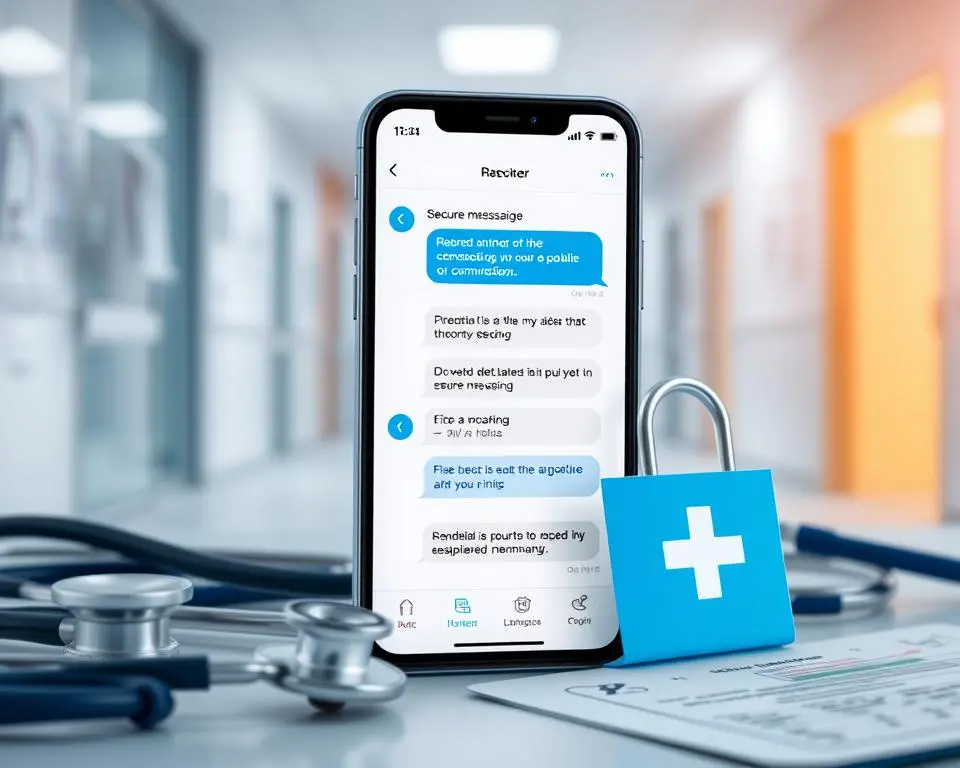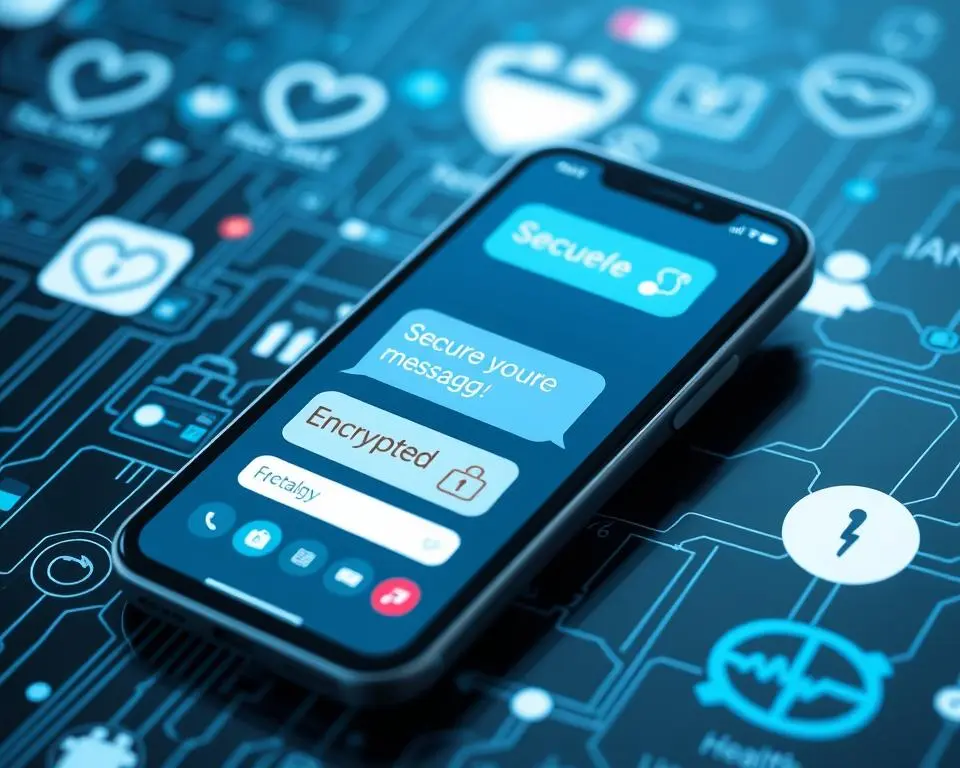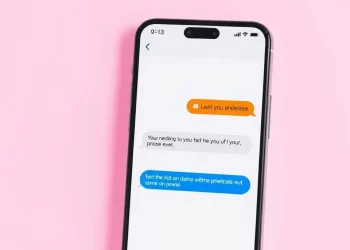Did you know 95% of healthcare providers use text messaging for patient care? Yet only 27% have a secure texting platform. This shows a big gap in using HIPAA-compliant texting in healthcare. As digital communication grows, keeping patient information safe is more important than ever.
In this guide, we’ll explore HIPAA-compliant texting and its role in healthcare, including legal needs and best practices. You’ll also learn to keep patient information safe and private in your healthcare group.

Key Takeaways
- HIPAA-compliant texting is crucial for secure patient communication
- Only 27% of healthcare providers use secure texting platforms
- Implementing HIPAA-compliant solutions protects patient privacy
- Healthcare text messaging must adhere to strict security standards
- Understanding legal requirements is essential for compliance
- Best practices help maintain HIPAA compliance in text communication
Understanding HIPAA and Its Implications for Text Messaging
Text messaging is key in healthcare today. But is it HIPAA compliant? Let’s dive into HIPAA and its role in healthcare chats.
What is HIPAA?
HIPAA, or the Health Insurance Portability and Accountability Act, guards patient health info. It outlines rules for handling sensitive data in healthcare when providers text patient details and when HIPAA and text messaging meet.
The importance of HIPAA in healthcare communication
HIPAA ensures patient privacy and data safety in text messages. It lets healthcare pros talk efficiently while keeping info safe. Using HIPAA-compliant systems builds trust with patients.
Challenges of texting in healthcare settings
Healthcare providers face particular hurdles with text messaging:
- Ensuring encryption of sensitive data
- Verifying recipient identity
- Maintaining audit trails for compliance
- Preventing unauthorized access to patient information
Overcoming these hurdles is key to HIPAA compliance. Healthcare groups must invest in secure messaging, train staff to use texting safely and protect patient information.
The Risks of Non-Compliant Texting in Healthcare
Texting is standard in healthcare, but using the wrong systems can cause big problems. Healthcare providers who don’t follow HIPAA messaging rules risk patient data and face legal issues.
Data breaches are a big worry in healthcare without secure text messaging. The wrong people can see patient information in unsecured texts, leading to identity theft, financial fraud, or blackmail.
Depending on how wrong the violation is, breaking HIPAA rules can lead to huge fines. Healthcare providers might also face lawsuits from patients, which can cost much money.
“The use of non-compliant texting in healthcare is a ticking time bomb. It’s not a matter of if, but when a breach will occur.”
Reputational damage is another considerable risk. If a healthcare organization can’t protect patient info, people lose trust. This can cause patients to go elsewhere, hurting the business and finances.
To avoid these risks, healthcare groups need a strong HIPAA texting policy. This policy should cover approved messaging, acceptable use, and how to handle sensitive info. Healthcare providers can keep patient data safe and their operations sound by focusing on HIPAA messaging compliance.
Key Features of HIPAA-Compliant Texting Solutions
HIPAA secure messaging systems have vital features to protect patient data. They let healthcare providers talk safely and competently.
End-to-end encryption
HIPAA-compliant SMS uses strong encryption. This keeps messages safe from unauthorized access during sending.
User authentication and access controls
Secure login and user permissions are key. They ensure that only the right people can see patient data in HIPAA-compliant chat systems.
Audit trails and logging
Message activity records are detailed. They are essential for following rules and checking for security issues.
Secure data storage and transmission
HIPAA-compliant texting solutions use safe servers and methods, keeping patient information safe when it’s stored and sent.
| Feature | Benefit |
|---|---|
| End-to-end encryption | Prevents message interception |
| User authentication | Ensures authorized access only |
| Audit trails | Enables activity monitoring |
| Secure storage | Protects stored patient data |
With these features, healthcare groups can follow HIPAA rules. This keeps patient privacy safe while allowing healthcare pros to communicate effectively.
Implementing HIPAA-Compliant Texting in Your Healthcare Organization
Using HIPAA-compliant texting software in your healthcare group requires a solid plan. First, look at how you currently talk to each other and patients. See where using SMS for healthcare can improve things and help care more.

Then, find a HIPAA-compliant text messaging app that fits your needs. Look for things like end-to-end encryption, user checks, and logs. Make sure it works well with what you already have and is easy for your team to use.
After picking a solution, make a detailed plan for using it. This plan should include when things will happen, who will do what, and training for your team. Ensure your IT team is ready to make the new texting software work with your current setup.
Make clear rules for using the new system. These should cover what’s okay, how to handle data, and how to keep things safe. Train everyone on these rules and how to use the app correctly.
| Implementation Step | Key Considerations |
|---|---|
| Needs Assessment | Identify communication gaps and potential improvements |
| Software Selection | Evaluate features, compatibility, and user-friendliness |
| Implementation Planning | Set timelines, allocate resources, and prepare IT infrastructure |
| Policy Development | Create guidelines for usage, data handling, and security |
| Staff Training | Educate employees on policies and proper use of the app |
Lastly, keep an eye on how well the new system is working. Ask your team and patients for feedback to find out what’s working and what’s not. Keep your HIPAA-compliant texting up to date to stay compliant and effective.
Best Practices for HIPAA-Compliant Text Messaging
Healthcare groups need a solid plan to use HIPAA-compliant text messaging. They must also consider patient privacy while using healthcare SMS. Here are some critical steps to follow for compliance and safety.
Creating a Texting Policy
A strong HIPAA texting policy is essential. It should explain what’s allowed, how data is handled, and security steps. It must cover everything from getting patient consent to keeping messages.
Staff Training and Education
Teaching staff about HIPAA texting is vital. They must know how to use approved platforms, protect patient data, and spot risks. Regular updates help them stay current with policy changes and new threats.
Regular Security Audits
It is important to conduct security audits often to stay HIPAA compliant. These checks check whether current security works, find weak spots, and suggest fixes for the texting system.
| Best Practice | Description | Importance |
|---|---|---|
| Texting Policy | Detailed guidelines for HIPAA-compliant messaging | Establishes rules and expectations |
| Staff Training | Education on the proper use of healthcare SMS | Ensures consistent compliance across the organization |
| Security Audits | Regular assessment of texting system security | Identifies and addresses potential vulnerabilities |
Following these best practices helps healthcare groups stay HIPAA compliant. They can then enjoy the benefits of texting with patients efficiently.
Top HIPAA Compliant Texting Software and Apps
Finding the right HIPAA-compliant messaging solution is critical for healthcare groups. Look at top picks that ensure secure chats and follow the rules.

OHMED is a standout for secure health talks. It has end-to-end encryption, user checks, and logs to keep things HIPAA-compliant. Its simple design makes it easy for doctors to send and get messages safely.
Jotform’s HIPAA-compliant text reminders take a special approach to talking to patients. It works with current systems, letting doctors send out reminders and updates while adhering to HIPAA rules.
When picking a HIPAA-compliant messaging tool, think about how easy it is to use, how well it works with other systems, and the cost. Here’s a look at some well-known choices:
| Software | Key Features | Pricing Model |
|---|---|---|
| OHMED | End-to-end encryption, user authentication, audit trails | Per user/month |
| Jotform | Automated reminders, form integration, customizable templates | Tiered plans |
| TigerConnect | Role-based access, message lifespans, EHR integration | Custom pricing |
When choosing a HIPAA-compliant messaging tool, consider what your group needs, budget, and tech you already use. The right software can improve communication, help patient care, and keep you following the rules.
Legal and Regulatory Considerations for HIPAA-Compliant Texting
Understanding the legal side of healthcare communication is critical. HIPAA-compliant texting requires careful attention to many rules and standards.
HIPAA Security Rule Requirements
The HIPAA Security Rule has strict rules for protecting patient data. Texting must meet certain criteria to be HIPAA compliant, including using end-to-end encryption and access controls.
Healthcare providers must make sure their texting follows these rules.
State-Specific Regulations
Many states have laws on healthcare communication besides HIPAA. These laws can affect how healthcare providers text. Some states require extra safety measures or have stricter rules for sharing patient information via text.
International Considerations
Healthcare groups working across borders face international rules. The use of live captions is HIPAA compliant in the US, but other countries might have different rules. Knowing and following local data protection laws is vital when texting patients or sharing medical info abroad.
Is SMS HIPAA compliant? It depends on how it’s used. Standard SMS usually doesn’t meet HIPAA standards. Healthcare providers need unique HIPAA-compliant texting solutions to follow all rules and protect patient privacy.
“Navigating the complex web of healthcare communication regulations can be challenging, but it’s essential for maintaining patient trust and avoiding costly penalties.”
By keeping up with these legal and regulatory aspects, healthcare providers can ensure that their texting is effective and compliant.
The Future of HIPAA-Compliant Texting in Healthcare
The world of HIPAA-compliant texting is changing fast. Healthcare providers are using secure messaging to better care for patients and communicate more easily. As tech gets better, HIPAA SMS will become easier to use.
Artificial intelligence and machine learning will change HIPAA text messaging a lot. They will improve security, automatically check for compliance, and spot risks quickly. Healthcare will have more intelligent systems to keep text messaging safe and follow HIPAA rules.
Another big change is linking HIPAA-compliant texting with electronic health records (EHRs). This will make talking between healthcare teams easier while keeping patient information private. As more places use these systems, asking if text messaging is HIPAA compliant will be less of a deal.
The future of HIPAA-compliant texting in healthcare is bright. With new tech and a focus on safe communication, healthcare providers will have better ways to share information and care for patients.
FAQ
What is HIPAA-compliant texting?
HIPAA-compliant texting means using secure text messaging that follows Health Insurance Portability and Accountability Act (HIPAA) rules. It protects patient health information (PHI) when sent electronically.
Why is HIPAA compliant texting important in healthcare?
In healthcare, HIPAA-compliant texting is key to keeping patient data safe. It ensures that sensitive information is not leaked. This way, healthcare providers can talk securely, keeping patient privacy safe and avoiding legal issues.
What are the risks of non-compliant texting in healthcare?
Not using secure texting in healthcare can cause big problems. It can lead to data leaks, legal troubles, fines, and harm to a hospital’s reputation. It also risks patient privacy and breaks HIPAA rules, leading to hefty penalties.
What are the critical features of HIPAA compliant texting solutions?
Reasonable HIPAA-compliant texting solutions have vital features. These include end-to-end encryption, user checks, and logs. They also store and send data securely to protect PHI and follow HIPAA rules.
How can healthcare organizations implement HIPAA-compliant texting?
Healthcare groups should pick the right software or apps to use HIPAA-compliant texting. They need to integrate it with their systems, make texting rules, train staff, and check security often.
What are some best practices for HIPAA-compliant text messaging?
For safe texting, make a texting policy, train staff, and check security often. This helps keep communication secure and follows HIPAA rules.
Are there any popular HIPAA-compliant texting software or apps?
Yes, there are many HIPAA-compliant texting tools. Some are OhMD, Jotform, TigerConnect, Spok Mobile, and Vocera. They offer different features and prices to fit various healthcare needs.
Are there any legal or regulatory considerations for HIPAA-compliant texting?
Healthcare groups must also consider state laws and global rules in addition to HIPAA. The HIPAA Security Rule has specific rules for keeping ePHI safe during communication.
Is SMS (traditional text messaging) HIPAA compliant?
No, regular SMS is not HIPAA compliant. It lacks security features like encryption and logs. Healthcare groups need unique texting solutions to handle PHI safely.














